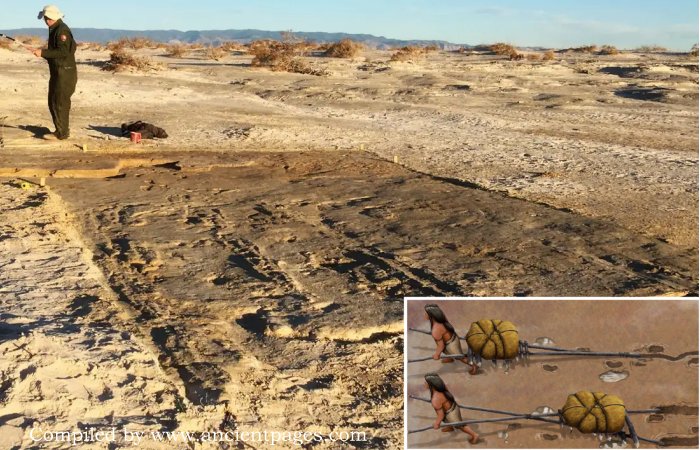Conny Waters – AncientPages.com – Scientists have uncovered preliminary evidence of transport technology utilized by the earliest known settlers in the USA, dating back over twenty thousand years.
A research team from Bournemouth University identified a series of drag marks at White Sands National Park in New Mexico. These marks are believed to have been created by makeshift vehicles constructed from wooden poles, found alongside ancient human footprints.
The illustration shows two variations of the travois, a type of sledge that ancient peoples in North America might have utilized. Credit: Gabriel Ugueto
Earlier studies conducted by these researchers revealed that some footprints in the park are approximately 23 thousand years old, thereby revising historical timelines and extending the date of earliest known human activity in the Americas.
“We know that our earliest ancestors must have used some form of transport to carry their possessions as they migrated around the world, but evidence in the form of wooden vehicles has rotted away,” said Professor Matthew Bennett of Bournemouth University who led the study. “These drag-marks give us the first indication of how they moved heavy and bulky loads around before wheeled vehicles existed,” he added.
The team discovered various types of tracks during their study. Some tracks were composed of a single line, likely formed by dragging two poles joined at one end. Other tracks featured two parallel lines, indicating they were made from two poles crossed in the middle. Such vehicles are known as “travois,” historically used by Indigenous Peoples in North America.
White Sands. Drag-marks consisting of parallel ridges. Credit: Bournemouth University
The uncovered track lengths vary from two to fifty meters and have been preserved in dried mud, later buried by sediment. The presence of these tracks alongside human footprints suggests that the travois were pulled by people rather than animals. Many footprints appear to belong to children, leading researchers to believe that groups of children accompanied or walked beside adults who pulled the travois. Indigenous People participating in studies at White Sands National Park concurred with this interpretation.
“Many people will be familiar with pushing a shopping trolley around a supermarket, moving from location to location with children hanging on. This appears to be the ancient equivalent, but without wheels,” Professor Bennett said.
In White Sands National Park, New Mexico, researchers have identified drag marks created by ancient vehicles. Credit: Bournemouth University
To give further validation to their theories, the team assembled their own simple travois out of wooden poles, which they then dragged along the mud flats of Poole Harbour in Dorset, UK, and on the coast of Maine, USA.
“In our experiments, our footprints and lines in the mud from the poles had the same appearance as the fossilized examples that we found in New Mexico,” Professor Bennett explained.
Dr Sally Reynolds, from Bournemouth University, added, “Every discovery that we uncover in White Sands adds to our understanding of the lives of the first people to settle in the Americas. These people were the first migrants to travel to North America, and understanding more about how they moved around is vital to being able to tell their story.”
The study is published in the journal Quaternary Science Advances.
Written by Conny Waters – AncientPages.com Staff Writer











